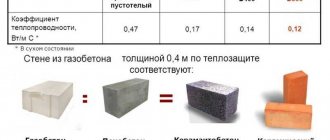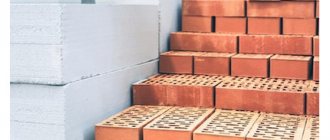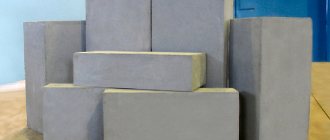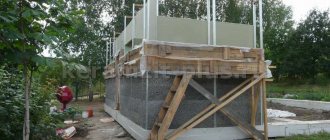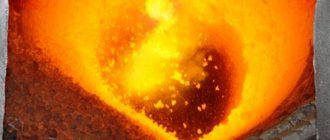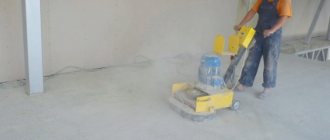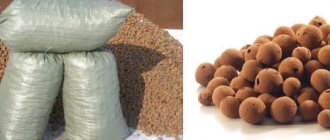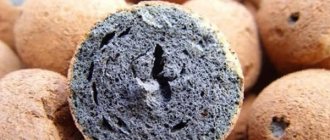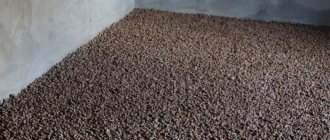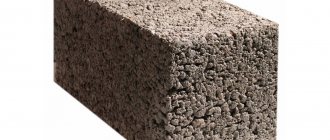Density
The production of expanded clay is based on the process of firing granules made from low-melting clays with intumescent properties under special conditions.
- True density of expanded clay
- Specific density of expanded clay
Different densities of expanded clay gravel are achieved by clay processing mode. There are four such modes:
- wet;
- dry;
- plastic;
- powder-plastic.
Since the density of expanded clay is low, the density of expanded clay concrete and the density of expanded clay concrete blocks, building materials based on expanded clay, are much lower than those of other materials. Despite the fact that the density of expanded clay is low, this does not affect its mechanical strength. The internal structure of finished expanded clay granules increases its resistance to high loads and protects blocks, panels or monolithic products from destruction.
The dimensions of expanded clay granules serve as the basis for separation into main fractions:
— sand (fraction size 0–5 mm);
— gravel (includes 3 types: 5-10; 10-20; 20-40 mm);
— expanded clay crushed stone or crushed fraction (0-10 or 5-40 mm).
Expanded clay, as one of the light porous fillers, has an important characteristic necessary for choosing a fraction - the density of bulk expanded clay. The volume of grains and volumetric bulk density, together with the porosity index, determine the quality of the material as a heat insulator. In general, the range of values within which the density of bulk expanded clay varies is from 250 to 800 kg/m. cube Moreover, the density of expanded clay gravel has its own limits for each brand. M300 grade gravel can have a density value from 250 to 300 kg/m3. You can see more detailed data on the density values of expanded clay on the page “expanded clay weight”. Larger fractions of expanded clay have a larger volume with less mass.
You should be careful and distinguish between two concepts when making calculations: the true density of expanded clay
and
specific density of expanded clay.
True density of expanded clay
True density of expanded clay (Pu)
– mass of a unit volume of expanded clay (m3) in a dense state. This is necessary to determine the specific gravity of the material. When calculating specific gravity, the weight of the material (dry) is used divided by the volume of the substance, excluding pores:
pu=m/Va, where Va is the volume of the material (in a dense state), and m is its mass. True density is a constant value for a particular material. But since expanded clay is a porous material, another characteristic is more important for it - specific density.
Specific density of expanded clay
Unlike true density, this value is variable. It can vary within the following limits:
— for expanded clay gravel — 450-700 kg/m3;
— for expanded clay-crushed stone — 600-1000 kg/m3;
— for expanded clay concrete dry mixture — 800 kg/m3;
The density of expanded clay concrete depends on its type. It comes in three types:
— structural, bulk density of which is from 1200 kg/m3 to 1800 kg/m3;
— thermal insulation, the bulk density of which is from 350 kg/m3 to 900 kg/m3;
- thermal insulation and structural, bulk density of which is from 700 kg/m3 to 1400 kg/m3.
Expanded clay concrete blocks have a number of advantages over bricks:
- since the density of expanded clay blocks is less than the density of brick, block masonry is 2.5 times lighter than brick:
— the volume of one block is equal to the volume of seven bricks, which speeds up the laying threefold;
— the thickness of walls made of expanded clay blocks is less, and the thermal insulation is better.
The low density of expanded clay blocks allows the construction of walls with low weight, significantly reducing the load on the foundation and reducing the cost of foundation work.
Another significant advantage of the fact that the density of expanded clay blocks is low is the reduction of heat loss by up to 75%. Expanded clay is one of the best as a wall material, which is why ready-made wall panels are made from it. The density of an expanded clay concrete panel depends on its design: single-layer, two- or three-layer. In industrial construction, the density of an expanded clay concrete panel (single-layer) is from 900 to 1100 kg/m3, and in the case of two- or three-layer panels, a layer (or 2 layers) of structural expanded clay concrete provides load-bearing capacity, and large-porous expanded clay concrete (density from 500 to 600 kg/m3 ) provides thermal protection.
Tweet
Expanded clay manufacturing technology
Specialized clay is used as a raw material for the production of expanded clay. In general, the process comes down to firing the raw materials. Before turning into the final product, clay must go through all technological stages of processing. At the last stage, over a short period of time, which usually takes from 20 to 40 minutes, the temperature increases from an initial value of 1050 to 250 degrees Celsius.
An interesting effect is observed - swelling of the heated mass, pores (or voids) are formed inside, i.e. cells filled with air. The result is durable granules, the surface of which melts under high temperature, forming an airtight shell. Granules are able to withstand moderate mechanical loads.
Basic properties of expanded clay, its varieties
Expanded clay gravel
These are pellets with a porous interior and a surface melted by high temperature. The lion's share of the expanded clay filler produced in the Russian Federation is gravel.
As noted above, gravel has an oval shape. Its surface is dark brown, usually almost black at the fracture.
Expanded clay filler is produced in the form of pellets ranging in size from 5 to 40 mm. In addition to fire resistance and moisture resistance, it is also distinguished by the fact that it does not contain substances that are contraindicated for cement. To produce expanded clay filler, specialized equipment with a rotating kiln is used.
Expanded clay crushed stone
Expanded clay crushed stone is produced by crushing large pieces of expanded clay foam. Unlike gravel, it has a random, angular shape.
The production of expanded clay filler uses the natural properties of clay, namely the release of gases and the presence of a pyroclastic state. The transition to this state in clay occurs under the influence of maximum temperature. In this state, a melt (liquid phase of the aggregate state of the substance) is formed and its swelling (boiling) occurs. At the same time, expanded clay receives another property - gas impermeability.
Expanded clay sand
The production of expanded clay sand is carried out in several ways: using a classic rotary kiln, mechanically, using a vertical furnace in a fluidized bed.
For the production of expanded clay sand, it is not always advisable to use classical furnaces. This is due to the fact that with such small grain sizes, it simply does not have time to foam, so sand is produced using roller crushers, crushing large pieces. To produce 0.5 m3 of sand, 1 m3 of finished expanded clay is consumed. The second effective way to produce sand is firing in a “fluidized bed”.
The essence of this technological process is as follows: pre-prepared clay chips with diameters from 3 to 5 mm are placed in an oven with a vertical chamber. Air under pressure is supplied to such a furnace and gas fuel is sprayed.
The combination of air and fuel under given conditions allows the solid crumbs to pass into a liquefied state. The supply of atomized fuel directly into the layer of clay raw material heats it evenly and causes boiling (swelling).
The density of expanded clay sand is about 500 – 700 kg/m3. The technical requirements for expanded clay sand are approximately the same in comparison with ordinary river sand. The content of large granules should be significantly higher.
What fractions of expanded clay exist?
Interestingly, with a relatively low density, expanded clay has good strength. High indicators of the last parameter for granules are ensured by their specific structure. The material maintains its integrity while under enormous weight, but also thanks to this, various objects that come into contact with the granules remain protected. Due to the existing difference in granule sizes, there is reason to conditionally divide expanded clay into three types or fractions: crushed stone, gravel and sand.
Of the listed types, sand is considered the smallest fraction - the size of sand grains ranges from zero to five millimeters. Depending on the average size of the granules (in millimeters), gravel is conventionally divided into three subspecies:
- from 5 to 10;
- from 10 to 20;
- from 20 to 40.
Expanded clay crushed stone is formed from crushed gravel. The most popular fraction is called crushed expanded clay. Its particles measure no more than ten millimeters. The required density of gravel is achieved by using plastic, wet, dry and powder-plastic modes during the manufacturing process.
Supply and packaging of expanded clay 10-20
Expanded clay grade 10-20 is supplied in bulk or packaged (in standard bags). When shipping in bulk, payments for it are made based on the number of cubic meters of material supplied, when shipping in bags - based on the cost of a full bag.
For wholesale deliveries, which allow the buyer to save significantly, the minimum number of bags (volume) of expanded clay at which the wholesale price applies is initially agreed upon.
Expanded clay is a building material obtained by accelerated heating of clay raw materials, which can carry out the process of pore formation at a temperature in the oven of 1050 - 1300 C, within 25 - 45 minutes from the moment the heating begins.
- Gravel – oval shaped.
- Crushed stone - has a multifaceted shape with corners and edges.
- Sand.
GOST 9759-76, fundamental document on expanded clay. It regulates the expanded clay fractions: 5-10, 10-20 and 20-40 mm; it also specifies restrictions on the presence of other fractions in the expanded clay in the base fraction.
The table shows data on the tensile strength and brand of expanded clay filler. GOST divides the produced expanded clay filler into 10 grades, according to density, from 250 to 800. Thus, grade 250 is designated expanded clay filler with a density of up to 250 kg/m3.
To determine the density of expanded clay, measuring containers are used. The average water absorption value of expanded clay gravel ranges from 8 to 20%. Existing technologies for producing expanded clay have been developed in full accordance with this GOST.
Its frost resistance indicator is at least 25 cycles of temperature difference from minimum to maximum. In other words, the service life of the filler is at least 25 years.
The thermal conductivity characteristics of expanded clay may not always meet the requirements for resistance to low temperatures, so they require careful examination before use.
The thermal conductivity of expanded clay is determined by the number and size of air pores and their humidity. A decrease in this property of expanded clay can be influenced by the formation of the so-called glassy phase that appears in the pellets.
About bulk density and expanded clay grades
The density or bulk density of expanded clay, like all other materials, is measured in the same units - kilograms per cubic meter (kg/cubic m). When we talk about expanded clay, we mean its thermal insulation properties. The main parameters - cellularity, total volume of cells inside the granules, volumetric (bulk) weight - affect the quality of expanded clay. It is impossible to say unequivocally that the bulk density has such and such a numerical value - it ranges between 250 and 800 kg/m3. m.
This is because each brand has its own meaning. To distinguish them, a standard was introduced - the letter “M” and, accordingly, the number are written in front. For example, if the density is slightly less than 250 kg/cub. m, then the marking is “M250”. For densities ranging from 250 to 300 kg/cu.m. m – “M300”. Up to 450 kg/cu.m. m gravel is marked at intervals of 50, but then the difference in designations between two adjacent marks doubles and is equal to 100, i.e. M500, M600, etc.
This designation of brands according to the specified principle, which depends on the density of expanded clay, has the specific name GOST 9757-90. Of course, according to the established rules, grades of crushed stone and gravel made from expanded clay have conditional lower and upper limits, respectively, M250 and M600. But if necessary, these standards can be adjusted at the request of the customer, using a value exceeding M600.
In the case of expanded clay sand, the following standards apply: M500 – M1000. If the values of characteristics close to the lower threshold are reference values, then it is advisable to comply with the highest values. The following conclusion suggests itself: if you choose some fraction, then the quality indicators will be more preferable to that expanded clay, the weight of the granules of which is minimal.
Performance characteristics and scope of use of expanded clay 10-20
The main working physical characteristics of expanded clay of fraction 10-20 are as follows:
- Bulk density - 400-500 kg/m3;
- Strength - P75-P100;
- Thermal conductivity - 0.094 W/mS;
- Frost resistance - F15.
All domestic expanded clay produced at construction industry enterprises complies with GOST 9757-90 and undergoes a full cycle of certification by authorized official organizations.
The main area of application of expanded clay 10-20 is reliable thermal and acoustic protection of interfloor ceilings, roofs, office premises, basements, walls, etc. The material is widely used in individual construction to set the depth of foundations and the height of floors. It is also in demand as the basis of expanded clay concrete blocks.
What other types of expanded clay density are there?
Knowledge of the true and specific density of bulk insulation is a prerequisite for performing calculations. Each material has its own specific density value. For example, in the case of expanded clay gravel, it can vary from 450 to 700 kg/cubic meter. m, and in the case of expanded clay concrete dry mixture – about 800 kg/cu.m. m. The specific density of expanded clay crushed stone is in the range of 600-1000 kg/cub. m.
True density is determined using a simple formula: the result of dividing the mass of a substance in a dry state by its volume (less the volume of the cells inside the granules). It follows from this that the true density of bulk insulation, which is expanded clay, belongs to the category of constant values.
Advantages and disadvantages of the material
As a result of the analysis of these varieties of expanded clay, the conclusion suggests itself that it is better to choose gravel as insulation. Its advantage
confirmed by a set of properties:
- Durability.
Retains its qualities for a long time. - Fire resistance.
The material is absolutely not flammable. - Chemical inertness.
Not affected by acids and other chemicals. - Biostability.
Resistant to fungus formation and does not allow rodents to enter. - Frost resistance.
Stable under temperature fluctuations. Tolerates more than twenty shifts of freezing and thawing. - Low bulk density.
From 250 to 800 kg/m3. The larger the fraction, the lower the density. - High strength.
- Good heat and sound insulation.
A consequence of low thermal conductivity, about 0.16 W/m, and porosity. - Ecological cleanliness.
Does not emit harmful substances.
It is worth considering separately the reaction of expanded clay to water
. It has solid water resistance and, if the gravel is dried after wetting, all parameters will be restored.
But at the same time, expanded clay has noticeable moisture absorption. Gravel soaked in moisture gains weight and loses insulating properties.
. Therefore, do not forget about waterproofing.
Important!
When insulating horizontal and inclined surfaces with expanded clay gravel using the dry filling method, use dense polyethylene film or bitumen-based roll material for vapor barrier. To ensure airtightness, the sheets are laid overlapping, and on the side walls they are folded to the level of the backfill.
Compare
Table 1 will help you with the technical characteristics of various types of insulation
Table 1
. Basic technical characteristics of some popular insulation materials
| Name of insulation | Specific gravity, bulk density, kg/m 3 | Thermal conductivity, W/(m*S) | Moisture absorption coefficient,% |
| Expanded clay (gravel) | 250 | 0,099 | 10-20 |
| Same | 300 | 0,108 | 10-20 |
| « | 350 | 0,115 | 10-20 |
| « | 400 | 0,12 | 10-20 |
| « | 450 | 0,13 | 10-20 |
| « | 500 | 0,14 | 10-20 |
| « | 600 | 0,14 | 10-20 |
| Foam glass | 200-400 | 0,07-0,11 | 0,05 |
| Fiberglass mats | 150 | 0,061 | 10-130 |
| 40-180 | 0,036 | 50-225 | |
| 40-80 | 0,029-0,041 | 18-50 | |
| 125 | 0,052 | 3-5 |
The table is based on data from SP-23-101-2004
and advertising sites.
Gravel consumption
It is not difficult to determine, given its loose form. When filling large areas, you simply need to calculate the required volume. And 0.1 cubic meters are spent on insulating surfaces. m per layer of 10 cm per 1 m 2.
On a positive note
The use of expanded clay in home insulation measures should be recognized:
- We guarantee that having completed all the work correctly, the house will be insulated for its entire service life.
- The material does not emit harmful substances.
- The opportunity to do everything yourself. Minimal skills required.
Coefficient of thermal conductivity
expanded clay gravel is slightly higher than that of modern synthetic and mineral insulation. This leads to the main disadvantage, which manifests itself in the significant thickness of the insulating layer and an increase in the thickness of the walls. It is advisable to take this incident into account at the design stage.
Reviews about expanded clay
Alexander, 42 years old, Volgograd: “I used expanded clay to screed the floor in the bathroom and toilet. Waterproofing “Osnovit”, 7 cm layer filled with cement laitance, cement-sand screed and tiles on top. It’s normal, it’s warm.”
Alexey, 38 years old, Saratov: “I covered the ceiling of the attic of an old house with expanded clay with a layer of 20 cm. It became warmer, and the rain was less audible.”
As you know, complete insulation of a private house is simply physically impossible without insulating the ceiling: it is from there that the strongest wind pressure “blows”, cold air comes in in winter and too hot air in summer. For example, if you insulate the walls and do not do the same with the ceiling, all the work will go down the drain, since it will give absolutely no effect (all the heat will simply go “to the ceiling”).
Expanded clay
LLC "Roof" / Insulation materials / Expanded clay Price - on request
Do you want to buy Expanded clay in Moscow? Call now, 8 (495) 666-26-10,
Bulk expanded clay is an artificially produced environmentally friendly material.
Expanded clay product description.
Expanded clay gravel by firing clay (shale) produces a porous material. Expanded clay gravel has an oval shape. A cubic shape with sharp corners and edges is inherent in expanded clay crushed stone. The smallest fraction is expanded clay sand. At the fracture, the expanded clay granule looks like hardened foam, representing a unique natural composition from planet Earth. Expanded clay price per cube, see price list.
Expanded clay technical characteristics.
Expanded clay building material. Expanded clay characteristics: the volumetric weight of dry expanded clay (bulk density) usually ranges from 350 to 600 kg/m3, but can be higher, and be up to 800 kg/m3. Cheap expanded clay usually has a higher density. "Expanded clay" is produced in accordance with GOST 9757-90 gravel, crushed stone and artificial porous. Technical conditions. The thermal conductivity coefficient of Expanded clay varies depending on the fraction of expanded clay and the bulk density of Expanded clay, and is 0.1-0.18 W/(m°C) as for building bricks. How to find out the weight of Expanded clay by fractions. Knowing the bulk density of Expanded clay and the Expanded clay fraction, you can find out what the weight of Expanded clay is in 1 m3, while relative air humidity plays a significant role, because the Expanded clay material has a porous structure. Find out the cost of Expanded Clay per cubic meter at Krovlya LLC.
Expanded clay grades and fractions.
Expanded clay GOST 9757-90 classifies expanded clay fractions by size and grade of expanded clay.
1) Expanded clay fraction 5-10 mm. (anything less than 5 mm is sand)
2) Expanded clay fraction 10-20 mm.
3) Expanded clay fraction 20-40 mm.
4) It is allowed to produce expanded clay gravel and expanded clay crushed stone of fractions from 2.5 mm. up to 10 mm. and mixtures of fractions from 5 mm. up to 20 mm, and for heat-insulating backfills from 5 mm. up to 40 mm. (as agreed with the consumer). Unit of measurement Expanded clay m3. Buy expanded clay from the manufacturer in Moscow - call now!
Expanded clay bulk density.
Expanded clay has a bulk density of more than 10 grades from 250 kg/m3 to 1100 kg/m3. (With a bulk density of 200 kg per 1 cubic meter, it has a thermal conductivity coefficient of 0.06 W/(m°C)). Expanded clay compressive strength. Expanded clay with delivery price is indicated in the price list per cubic meter. Expanded clay has the following strength characteristics: from P15 to P400. Expanded clay for flooring price per m3 is indicated in the price list without a discount. Each brand of Expanded clay is tested for strength when compressed in a cylinder. The volumetric weight of Expanded clay depends on the fraction.
Expanded clay application.
Expanded clay gravel fraction 20-40 mm.
Expanded clay Large. Expanded clay in bags, scope of application of Expanded clay 20-40mm: with a large layer of expanded clay backfill (for insulating attic floors, for insulating foundations (internal, external), for insulating floors (filling underground space, backfilling the floor with Expanded clay). Gardeners use expanded clay as drainage gravel fraction 20-40 (for planting bushes and trees) Expanded clay 20-40 price per m3 is indicated in the price list without delivery.
Expanded clay gravel fraction 10-20 mm.
Expanded clay in bags Application of Expanded clay 10-20 mm: for insulation with Expanded clay of roofs, wooden floors, heat insulator in well masonry of a house, water supply system, sewerage system. When installing drainage systems, builders also use expanded clay gravel with a fraction of 10-20 mm as drainage. The price for Expanded clay 10-20 is indicated per m3.
Expanded clay gravel fraction 5-10 mm.
Use of expanded clay 5-10 mm in bags: when installing “warm floors” as backfill and as a filler for warm concrete. Gardeners use expanded clay gravel of fraction 5-10 as drainage for small plants. "Expanded clay 5-10" price per m3 is indicated in the price list. Leveling the floor with expanded clay is always economically justified.
Expanded clay fraction 0-2 mm. (expanded clay sand)
A component of warm masonry mortar, the use of which reduces cold bridges in brickwork. Expanded clay 0-2 is used as a dry backfill. For expanded clay chips Keramzit Moscow the price per m3 is indicated in the price list. Small expanded clay price per m3 is cheaper at Krovlya LLC.
Expanded clay material properties.
- Environmentally friendly, natural material Expanded clay.
- Heat and sound insulation with expanded clay.
- Expanded clay has high strength and chemical inertness.
- The durability of expanded clay - I fell asleep and forgot about it.
- Frost resistance, fire resistance.
- The optimum ratio of price and quality.
The history of the appearance of expanded clay.
At the beginning of the last century, the Russian people began to use swollen bricks as lightweight concrete aggregates. At the same time, the Yankees came up with the idea of firing clay plates and obtained the material khaidit, which they then broke to the desired size. See pictures and Expanded clay photos above. Expanded clay production is carried out at an expanded clay plant. In the 30s of the last century, Soviet engineers improved this process and began to produce clay granules. They were quickly fired in rotary kilns to produce porous granules with a durable surface. The price for 1 m3 of Expanded clay is the best in Krovlya LLC.
Expanded clay composition.
"Expanded clay" can be different. It is a baked light clay, which is subjected to high-temperature shock during the manufacturing process. This firing method causes the clay to swell, numerous bubbles and pores are formed (they do not sink in water), which, due to the presence of air in them, give expanded clay the ability to retain heat. It’s easy to buy lightweight Expanded Clay in Moscow, call and get the best price offer for Expanded Clay from Krovlya LLC.
Expanded clay production technology.
How did expanded clay appear? Expanded clay production technology is not so complicated. Clay granules are fed into a rotating inclined drum 40 to 80 meters long. From the high to the low part of the drum, granules of the future Expanded Clay gradually heat up and move towards the burning nozzle. The future expanded clay gravel is burned and swells. Double-drum kilns rotating at different speeds are also used for the production of expanded clay. Such furnaces allow the use of lower quality raw materials without compromising the quality of the produced Expanded Clay. Expanded clay price is indicated in the price list per m3 without delivery. After 45 minutes, a strong, frost-resistant, durable, environmentally friendly, fireproof insulation appears. And its name is “expanded clay” (expanded clay gravel, expanded clay crushed stone, expanded clay sand). Buy expanded clay in Moscow 8(495) 661-35-34.
Expanded clay application.
Today, expanded clay gravel in Russia is an affordable building material. You can buy Expanded clay at an affordable price from Krovlya LLC. The applicability of construction expanded clay is quite wide. The price for Expanded clay is indicated per m3 in the price list. Expanded clay types and brands may be different. Expanded clay has found its application in various spheres of human activity. Expanded clay and Expanded clay gravel are widely used in construction as economical insulation. Expanded clay insulation for floors, used for filling Expanded clay floors, walls, ceilings, basements, ceilings. Expanded clay is used as a drainage and thermal insulation material for earth embankments of roads, which are laid in water-saturated soils. The use of expanded clay floor heating is quite relevant today. Expanded clay has found its application as a decorative material that allows for proper thermal insulation of soil and lawns. Expanded clay for flowers is used as drainage. Expanded clay crushed stone is also used as a filler for lightweight concrete. Bulk floors are made using Expanded clay. Expanded clay concrete floor screeds are made using Expanded clay. To avoid wet processes (traditional floor screed), there is a dry floor technology that contains expanded clay sand. Expanded clay and gypsum plasterboard flooring, Expanded clay consumption is calculated individually, depending on the work performed, Expanded clay consumption rates differ. You can also insulate a country house with expanded clay. Instead of expanded clay, it is quite possible to replace it with foam glass; this is possible, with an economic justification. When purchasing fine expanded clay in bags, the price is per cubic meter. a meter lower at Krovlya LLC.
Expanded clay in construction.
Expanded clay gravel is used in construction as an independent bulk material for backfilling roofs, floors, walls, ceilings, ceilings (floor insulation, sound insulation or drainage), expanded clay fine sand is used as a dry backfill for floors. Expanded clay gravel is added to cement mortars and the so-called lightweight concrete mixtures “Expanded clay concrete” are obtained. You can make a floor screed with expanded clay with your own hands. In practice, from a solution with Expanded Clay, you can get finished finished products, such as expanded clay bricks or Expanded Clay blocks. Expanded clay is also included in the composition of “Expanded clay concrete blocks”. Laying expanded clay, depending on the type of proposed work, is systematic; if you follow the technology for laying expanded clay, you can get excellent results, depending on the type of work performed. Expanded clay price per 1 m3 varies due to its fraction.
Expanded clay packaging.
For ease of transportation and storage of the construction material Expanded clay, factories use the following packaging: woven polypropylene bags (Expanded clay in bags), kraft paper bags or soft big bag containers. Expanded clay bag volume can be different. You can buy Expanded clay in small wholesale in Moscow faster. To optimize costs, at the request of the client, Expanded clay can be supplied in bulk. Expanded clay price per m3 is indicated in the price list. The unit of measurement of Expanded clay is cubic meter. You can buy Expanded clay cheaply at krovtecho.ru.
Expanded clay certificates.
Expanded clay has a certificate of conformity and a fire certificate. A quality certificate is issued for the produced batch of expanded clay. Expanded clay certificate of conformity can be downloaded from the manufacturer’s website. Construction expanded clay price per m3 is indicated in the price list.
Expanded clay reviews.
Dear Clients. We ask you to leave your feedback about the bulk building material Expanded clay in the CONTACTS section. You can buy Expanded clay with delivery on our website. Krovlya LLC thanks you for your timely feedback on Expanded Clay of different fractions.
Buy Expanded clay, price in Moscow.
Call and find out how much Expanded clay in bags costs in Moscow per cube with delivery to your region. Expanded clay can be ordered in bags and in bulk quickly. It has become easier to buy expanded clay wholesale in the Russian Federation at a low price. Today, Krovlya LLC is the leading supplier of Expanded Clay to the Moscow region and surrounding areas. We sell Expanded Clay at a low price in bags and Expanded Clay in bulk. Long-term cooperation with the best manufacturers of expanded clay gravel has allowed our regular customers to appreciate the high quality of our expanded clay. Sale of expanded clay in bags at a competitive price only from Krovlya LLC. You can purchase expanded clay from the leading manufacturer of expanded clay crushed stone at “krovtecho.ru” at a competitive price. You can also find out the cost of Expanded clay bags, price including delivery. Our best expanded clay specialists will help you understand not only the technical characteristics of expanded clay, but also the features of its application, as well as make an expanded clay calculation and tell you which expanded clay is best for the floor. To do this, you just need to make a phone call. Buy Expanded clay in bags, the price is per m3. Buying Expanded Clay from the leading Moscow city, you receive: fast service and calculation of expanded clay (your personal manager is always aware of the availability of material at the plant, funds received from you, shipments of goods to your address, etc.), high-quality service, fast delivery, efficient document flow and high quality of service at LLC “Krovlya” will please you from the beginning of communication with our organization. Find out the cost of Expanded Clay per m3 in Northern Chertanovo. Which Expanded Clay is better, see technical specifications and price list. Keep an eye out for seasonal promotions. We wish you a pleasant shopping experience.
How work on insulation with expanded clay is carried out
Expanded clay gravel is very easy to work with
material. It does not require any special tools. You will need shovels, buckets (stretchers), ramming beams, a building level, usually a tape measure, beacons.
Consumable materials: vapor or waterproofing, tapes, etc. for gluing seams, cement for preparing “milk”
.
Foundation
For the foundation
thermal insulation is needed to protect against annual temperature fluctuations. The technology for its protection by filling with expanded clay is as follows:
- A trench is dug around the finished foundation with a depth corresponding to the amount of soil freezing. The trench width is at least 50 cm.
- In the resulting cavity, formwork is placed from available materials (boards, slate sheets).
- Waterproofing work is carried out on the bottom and side surfaces (film, roofing felt, etc.).
- Expanded clay gravel is filled to zero level and compacted. The surface is leveled.
- The insulation on top is also insulated from moisture.
- Then a blind area is made around the foundation or a thin layer of soil is poured.
Floor
Insulate the floor on a concrete base
from the cold from below will result from the step-by-step implementation of the following operations:
- The surface is carefully prepared. All rubbish is removed and any unevenness is leveled out.
- Vapor barrier is provided. The perimeter film is folded onto the wall to the height of the expanded clay layer.
- Beacons indicate a given level. You can fix the beacon slats with small lumps of solution.
- Expanded clay is poured when the solution under the beacon strips sets. It is better to take granules of different fractions
to obtain a more durable layer. - The embankment is leveled along the beacons with a lath or rule. And then it is poured on top with “cement laitance”
. - The final stage is cement screed. It is advisable to lay a reinforcing metal mesh on the expanded clay in front of it. The thickness of the screed is selected to be at least three centimeters.
Walls
Exterior walls
in the house are responsible for maintaining heat to the greatest extent. But the technology for insulating them with expanded clay is more complicated than for the floor or ceiling. Such walls must be erected by a professional mason.
The masonry is carried out in two layers
: internal (main) and external from facing bricks. The gap between the masonry is about ten centimeters, where the expanded clay is poured. Between the masonry, jumpers-ligaments are required.
Ceiling
Wooden ceiling
can be insulated with various materials, including expanded clay. First, the ceiling must be prepared. Check beams and ceiling boards. Replace unusable ones and, if necessary, rebreak the boards more tightly. After all, with insulation, the load will also increase.
Procedure
then like this:
- We cover the structure with a vapor barrier material. The joints need to be glued. Bend the edges to the height of the backfill.
- Pour expanded clay to the height of the beam.
- Apply a cement screed to the gravel layer or, in extreme cases, cover it with waterproofing.
- If the attic will be used as a living space or for storing things, lay a floorboard on top.
From all of the above, we can conclude that expanded clay rightfully occupies one of the leading places
among insulation materials.
How environmentally friendly expanded clay insulation is produced and used - watch the video:
